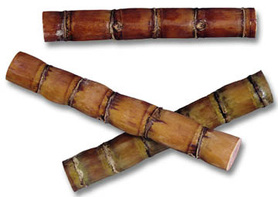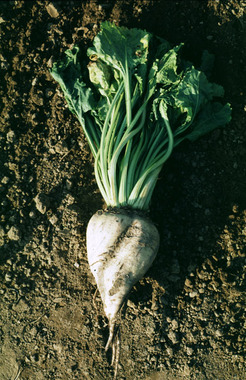Growing Sugar Cane
In the spring, sugar cane stem cuttings are planted in fields. As they grow, the stems multiply at the base, often producing a cluster of 2 or 3 stems. The stems thrive in full sunshine, and as they mature the sugar content increases. The lowest part of the cane is richest in sugar. Cut sugar cane re-grows, so plantations last for many years without having to replant. In Louisiana three crops will successively follow from a single planting; in the West Indies one laying will last from ten to twenty years.
Click here to get instructions for growing your own sugar cane at home!
Click here to get instructions for growing your own sugar cane at home!
Harvesting Sugar Cane - A Dangerous Job
When ripe (11-14 months), the canes are cut down close to the ground and stripped of the leaves, which are left to shelter the roots through the winter. Sometimes this trash is burned or ploughed under. The stems are usually cut manually and are bundled to be taken to a sugar mill.
Most harvesting of sugar cane is done with large, sophisticated machinery.
Click here to see a video of modern machinery harvesting sugar cane.
In less-developed countries, sugar cane harvesting is a hands-on, dirty, hot and dangerous job. The hours are long and there is high risk of field workers getting respiratory illness from breathing in the dust from waste sugar cane fiber. Debilitation and death from heat stroke is increasing as global warming increases.
Click here to see a video of sugarcane workers in the Dominican Republic
Most harvesting of sugar cane is done with large, sophisticated machinery.
Click here to see a video of modern machinery harvesting sugar cane.
In less-developed countries, sugar cane harvesting is a hands-on, dirty, hot and dangerous job. The hours are long and there is high risk of field workers getting respiratory illness from breathing in the dust from waste sugar cane fiber. Debilitation and death from heat stroke is increasing as global warming increases.
Click here to see a video of sugarcane workers in the Dominican Republic
Growing Sugar Beets
The sugar beet (Beta vulgaris L.) is a member of the Chenopodiaceae subfamily and the Amaranthaceae family, is a plant whose root contains a high concentration of sucrose. It is directly related to the beetroot, chard and fodder beet.
The sugar beet is a temperate climate biennial root crop. It produces sugar during the first year of growth in order to see it over the winter and then flowers and seeds in the second year. It is therefore sown in spring and harvested in the first autumn/early winter. The beet stores the sucrose in the bulbous root. Although the sugar beet plant has a larger percentage of sucrose by weight than sugar cane, cane produces much more sucrose per acre (and therefore, more molasses)
The sugar beet grows well in a variety of soil and climate conditions and has been successfully grown in 26 USA states. Canada produces sugar beets in Manitoba and Alberta. Russia leads worldwide production of sugar beets with nearly 8,500,000 acres, followed by Poland, France, West Germany and Turkey with about 1,000,000 acres each.
Up until the latter half of the 20th century, sugar beet production was highly labor-intensive, as weed control was managed by densely planting the crop, which then had to be manually thinned with a hoe two or even three times during the growing season.
The sugar beet is a temperate climate biennial root crop. It produces sugar during the first year of growth in order to see it over the winter and then flowers and seeds in the second year. It is therefore sown in spring and harvested in the first autumn/early winter. The beet stores the sucrose in the bulbous root. Although the sugar beet plant has a larger percentage of sucrose by weight than sugar cane, cane produces much more sucrose per acre (and therefore, more molasses)
The sugar beet grows well in a variety of soil and climate conditions and has been successfully grown in 26 USA states. Canada produces sugar beets in Manitoba and Alberta. Russia leads worldwide production of sugar beets with nearly 8,500,000 acres, followed by Poland, France, West Germany and Turkey with about 1,000,000 acres each.
Up until the latter half of the 20th century, sugar beet production was highly labor-intensive, as weed control was managed by densely planting the crop, which then had to be manually thinned with a hoe two or even three times during the growing season.
Harvesting Sugar Beets
In the past, harvesting also required many workers. Although the roots could be lifted by a plow-like device which could be pulled by a horse team, the rest of the preparation was by hand. One laborer grabbed the beets by their leaves, knocked them together to shake free loose soil, and then laid them in a row, root to one side, greens to the other. A second worker equipped with a beet hook followed behind, and would lift the beet and swiftly chop the crown and leaves from the root with a single action. Working this way he would leave a row of beet that could then be forked into the back of a cart.
Harvesting is now entirely mechanical. The sugar beet harvester chops the leaf and crown from the root, lifts the root, and removes excess soil from the root in a single pass over the field. A modern harvester is typically able to cover 6 rows at the same time. The beet is left in piles at the side of the field and then conveyed into a trailer for delivery to the factory. The conveyor removes more soil -a farmer would be penalized at the factory for excess soil in his load.
Click here to see a video of modern machinery harvesting sugar cane.
Harvesting is now entirely mechanical. The sugar beet harvester chops the leaf and crown from the root, lifts the root, and removes excess soil from the root in a single pass over the field. A modern harvester is typically able to cover 6 rows at the same time. The beet is left in piles at the side of the field and then conveyed into a trailer for delivery to the factory. The conveyor removes more soil -a farmer would be penalized at the factory for excess soil in his load.
Click here to see a video of modern machinery harvesting sugar cane.
Sorghum

A Mennonite family on Muddy Pond in Clarkrange/Monterray, Tennessee, cultivates sorghum for molasses production.
Grown in many parts of the United States, sorghum produces
Sweet sorghum syrup which is known in some parts of the United States as molasses, though it is not true molasses.
Sweet sorghum syrup which is known in some parts of the United States as molasses, though it is not true molasses.






